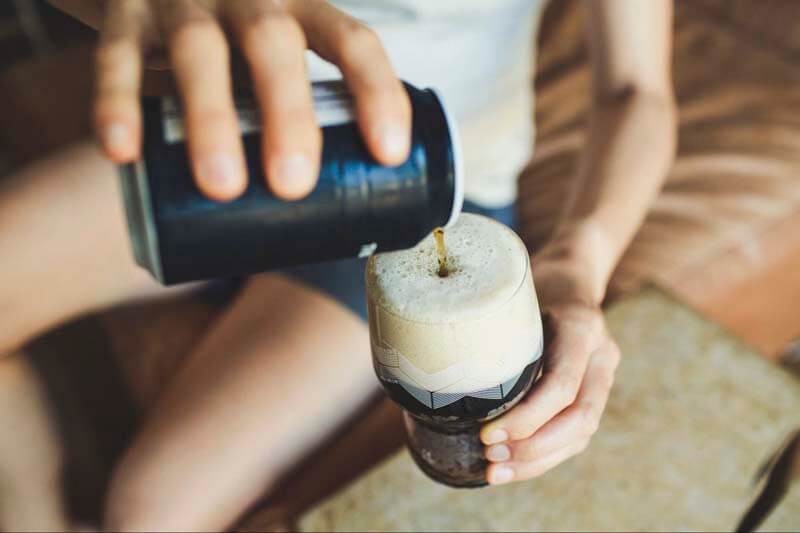
There has been a surge in the number of non-alcoholic breweries and brands popping up across the country and around the world.
In 2021, the non-alcoholic beer market in the United States recorded a revenue of nearly five billion U.S. dollars while the non-alcoholic beer industry generated 25.28 billion US dollars in revenue globally.
By 2025, revenue in the industry is expected to reach almost nine billion dollars.
On the lowdown, zero-proof beer continues to climb. The trend has American craft brewers jumping on board, creating non-alcoholic beers for customers seeking a more sobering experience.
Above Photo by Markus Spiske on Unsplash
Affordable, Industry-Leading Brewery Software
Why Bring a Non-Alcoholic Beer to Market?

Photo by Lance Anderson on Unsplash
With the increasing popularity of non-alcoholic beers, it is clear that this is not a passing fad, but rather a viable alternative to traditional drinking culture.
The surge of breweries manufacturing non-alcoholic beer has expanded worldwide, increasing the diversity and choice for customers who have elected to abstain from, cut, or limit their alcohol intake.
Brewing a non-alcoholic beer could create an additional revenue stream for breweries. But beyond the obvious potential for revenue, making a low-alcohol option shows your existing customers that every audience has value.
“When we compared this concept to our company’s core values, it became evident that our customers would appreciate a non-alcoholic beer,” says Jared Welch, co-owner and production manager at Southern Grist Brewing Company in Nashville, TN. “We recognized we could apply the same distinct approach to the non-alcoholic sector without abandoning our brand. We knew that with our experimental and unique approach to brewing, producing brews, we’d be up for the challenge.”
So far that dedication has had a big pay off with Southern Grist’s non-alcoholic fruited sour receiving the Bronze Award for Non-Alcoholic Beer at the 2022 World Beer Cup.
But just because non-alcoholic beer is trending upward, it doesn’t mean that it makes sense for every brewery to make its own alcohol-free version.
It’s important to understand the challenges, hurdles, and upfront costs before diving head first into non-alcoholic beer.
The Top Four Ways to Brew Non-Alcoholic Beer

Photo by Elevate on Unsplash
To make a non-alcoholic beer with the full flavor and balance of a conventional beer takes a lot of practice and a whole lot of capital S Science.
In the United States, a beer is considered non-alcoholic if it contains less than 0.5 percent alcohol by volume (some states have different thresholds).
As we all know, the development of alcohol is a key part in making beer. However, in the case of non-alcoholic beers, brewers have modified traditional processes or utilized modern technology to create alcohol-free beer. Traditionally, making non-alcoholic beer falls into two camps: reducing alcohol production or removing alcohol post-fermentation.
With the former, often referred to as limited or arrested fermentation, one tweaks the temperature and sugar level of the wort, ensuring it has less fermentable sugars. That way, when fermentation occurs, the yeast has less fermentable sugars to eat, producing less alcohol.
The latter, often referred to as dealcoholization, includes stripping a fully brewed beer of its alcohol content. Because a fermented beer is actually brewed, this method usually leads to fuller-flavored, higher-quality non-alcoholic beer.
There are a few different methods for dealcoholized beer including:
1. Membrane Filtration
Beer is filtered via a membrane that enables only alcohol, color, and some aromatic ingredients to pass through while excluding water. The alcohol is then distilled away, and water is added back to the beer.
2. Vacuum Distillation
A vacuum lowers the boiling point of beer from around 173°F to 93°F, allowing it to maintain flavor while still evaporating the alcohol.
3. Boiling Off the Alcohol
Adding water or steam to the beer heats it. Boiling the beer under pressure releases the alcohol as a vapor into a condenser, where it is collected and removed. However, this frequently has an adverse effect on flavor.
4. Reverse Osmosis
Like membrane filtering, reverse osmosis pushes beer through a semipermeable membrane under high pressure. The water is then separated from the alcohol by distillation and channeled back into the beer using special dealcoholized equipment.
For Southern Grist, the best method so far has been reverse osmosis.
“We had the most success extracting alcohol from “ordinary” beer using a reverse osmosis device to remove alcohol by simply exerting very high pressure to drive the beer through a membrane or “filter” capable of distinguishing different sized molecules,” says Welch. “One of the chemicals that gets pushed out is alcohol.”
Welch explains that he used the reverse osmosis technique because it was familiar to him to brew a beer as usual, then remove the alcohol.
It also helped to dedicate an entire year to sampling numerous non-alcoholic beers before he and his team began attempting to brew their own.
“During that time, I researched as much as I could about the beers and how they were made,” says Welch. “I discovered that the majority of the beers I liked best were prepared with membrane filtering. The alternative method of producing non-alcoholic beer relies on numerous methods of adjusting the general production procedure of the liquid which could include employing a different yeast strain or changing the way you brew.”
5 Factors to Consider When Making Non-Alcoholic Beer

Photo by Robert Mathews on Unsplash
1. Know Your Market, Do the Research
If your brewery is interested in the non-alcoholic market but not sure whether to invest, Welch recommends spending a lot of time initially studying various beers on the market, noting what customers appreciate or dislike.
Then, visit a brewery that produces an alcoholic beer, and if possible, compare the non-alcoholic and alcoholic versions to discover how the beverage changes.
“Reach out to close contacts at any brewery they have a relationship with that produces them, or if there is a contract manufacturing facility nearby, schedule a meeting to ask them questions, ” explains Welch.
You could even go a step further by putting out a survey to customers to see if they’d be interested in drinking a non-alcoholic version of some of your beers. If the resounding answer is no, then you probably don’t even need to spend the time or money on some of these other considerations.
2. Realize There Could be Additional Cost
One of the most challenging aspects of creating non-alcoholic beer, according to Welch, is keeping expenses under control in order to make it a profitable commercial venture.
Southern Grist’s non-alcoholic beers are brewed in the same time-intensive, adjunct-heavy brewing practices as their alcoholic beer.
“Given that we make the beer as usual, then it goes through additional processes, it may be argued that making non-alcoholic beer costs more than regular beer,” says Welch.
Additionally, making non-alcoholic beers can be more expensive thanks to the cost of the specialized machinery required to extract alcohol.
“You may decide that working with someone who is already producing [non-alcoholic beers] is preferable to attempting to do it in-house because some methods of producing non-alcoholic beer are costly,” says Welch.
Consider all your options and make the decision that’s right for your business.
3. Understand That Alcohol-Free Impacts Flavor and Texture … in a Good Way
The most surprising aspect about creating non-alcoholic beer for Welch was comparing it to how alcoholic beer actually tastes.
“It may sound unusual, but alcohol has a tremendous impact on everything from flavor to texture,” Welch explains. “It’s astonishing how much the end effect changes when you take that out.”
By removing the alcohol component, you may create a more punchy, drinkable mix with high-quality ingredients that stand out on the palate.
4. Use Fresh, High-Quality Ingredients
High-quality ingredients are always a certainty for Southern Grist’s beers. So, when it came to making non-alcoholic beer, Welch and his production staff wanted to stay true to the brewery’s brand by giving customers the same flavor and pleasure that they had grown to anticipate.
While building the flavor profile of Southern Grist’s award-winning non-alcoholic fruited sour, Parallel, Welch didn’t want to forgo the amount of real passion fruit or raspberries. Similarly, he didn’t want to reduce the number of Galaxy or Citra hops in Beacon, their non-alcoholic juicy IPA.
With Southern Grist’s non-alcoholic Parallel winning bronze at the 2022 World Beer Cup, it’s easy to agree with Welch’s decision to use premium ingredients.
“For us, it’s still about producing a product that people want to drink not only once, but repeatedly,” says Welch.
5. Keep Tweaking and Experimenting
Although there has been an influx of new non-alcoholic products on the market, this segment is still fairly fresh compared to the current American craft beer market.
Don’t be afraid to keep experimenting and tweaking your non-alcoholic recipes. If you have a question about a technique, flavor combinations, or ingredient substitution, Welch recommends consulting with a fellow professional brewer.
“The recipes were changed a bit over time, but it all came from interacting with folks I’d consider ’experts’ in the non-alcoholic realm, and it was incredibly helpful in moving our non-alcoholic beers from good to amazing,” says Welch. “The craft beer community is wonderful in supporting and learning from one another, which keeps us all in business.”
After all, brewing all that beer from grain to glass takes a lot of effort. Even when it’s alcohol free. At the end of the day, the goal remains the same: to brew the best beer possible, whether it’s a 14% ABV imperial stout or a 0.5% non-alcoholic sour.
“When we originally discussed developing non-alcoholic beer, I always emphasized that I didn’t want people to talk about them with a qualifier, like, ‘That is good for a non-alcoholic beer!’” says Welch. “Instead, we want customers to taste it and say, ‘Wow, there’s no alcohol in this?!’”

Photo by Markus Spiske on Unsplash
Focus on Brewing and Let Ollie Manage Your Inventory Levels
Before you brew, get your budget and materials in line. And when you do, let the software that was built by brewers for brewers help you and your production team create the best-tasting non-alcoholic beer on the market with Ollie.
With Ollie’s raw material forecasting technology, you’ll receive real-time notifications when your inventory levels are running low so that you can be on top of any issues at all times.
Ollie’s drag-and-drop scheduler makes it simple to schedule all your fermentations, too! Click on a date, schedule a brew, drag it around to put it right where you need it. It’s that easy. Request a free demo today.



